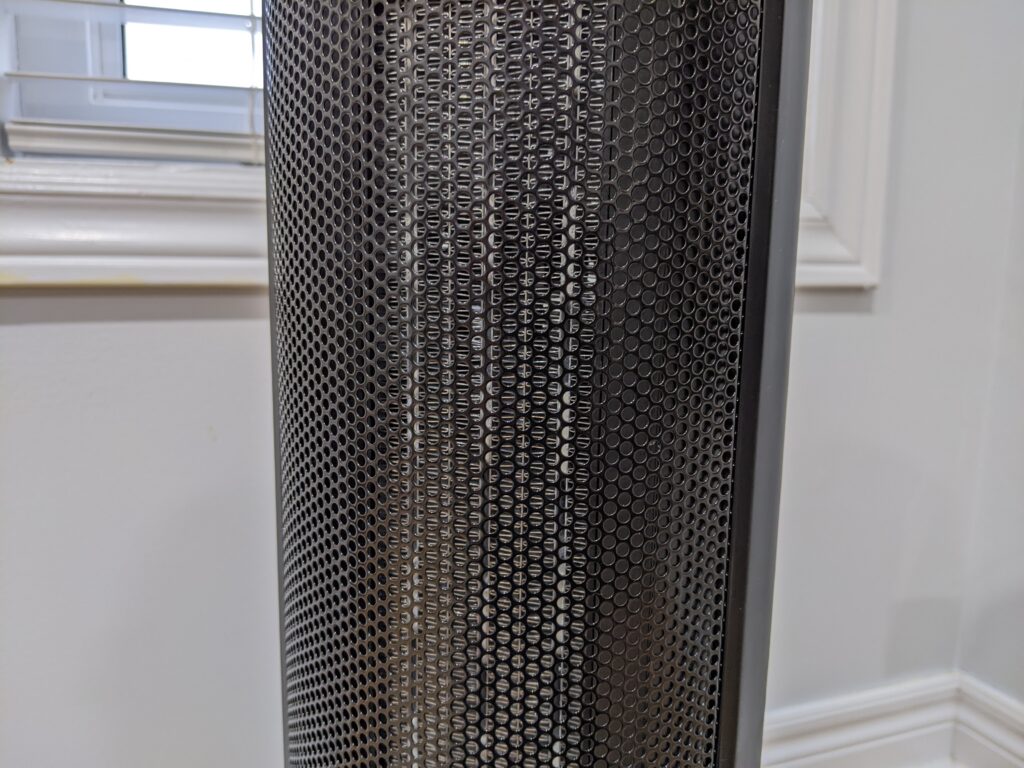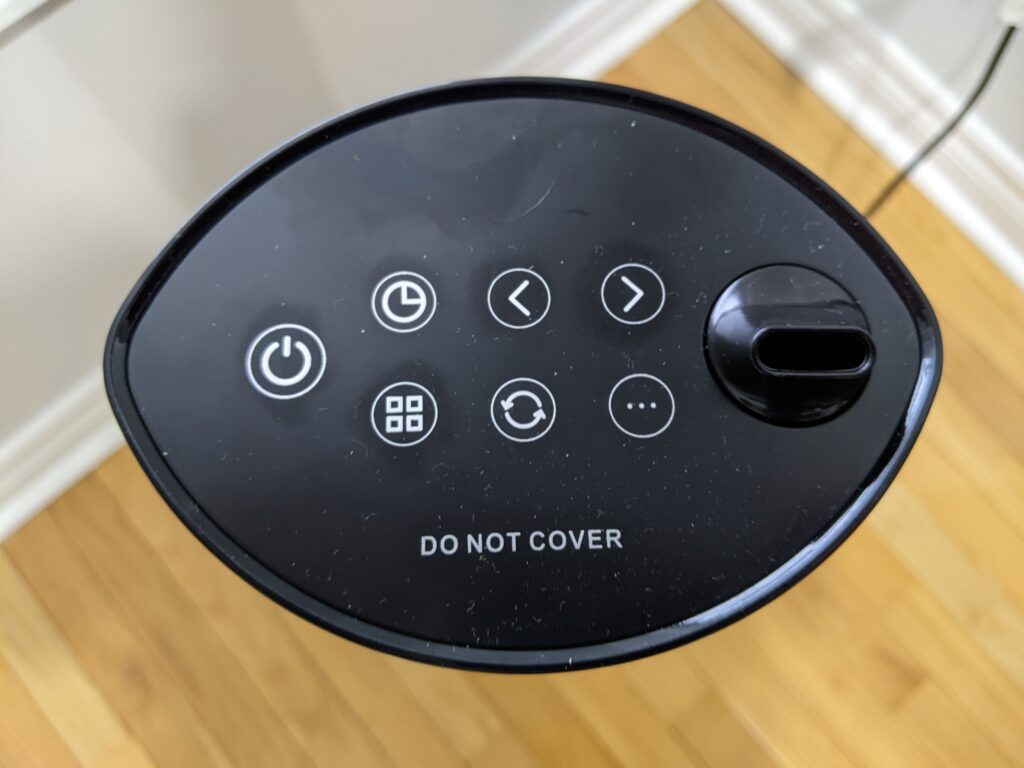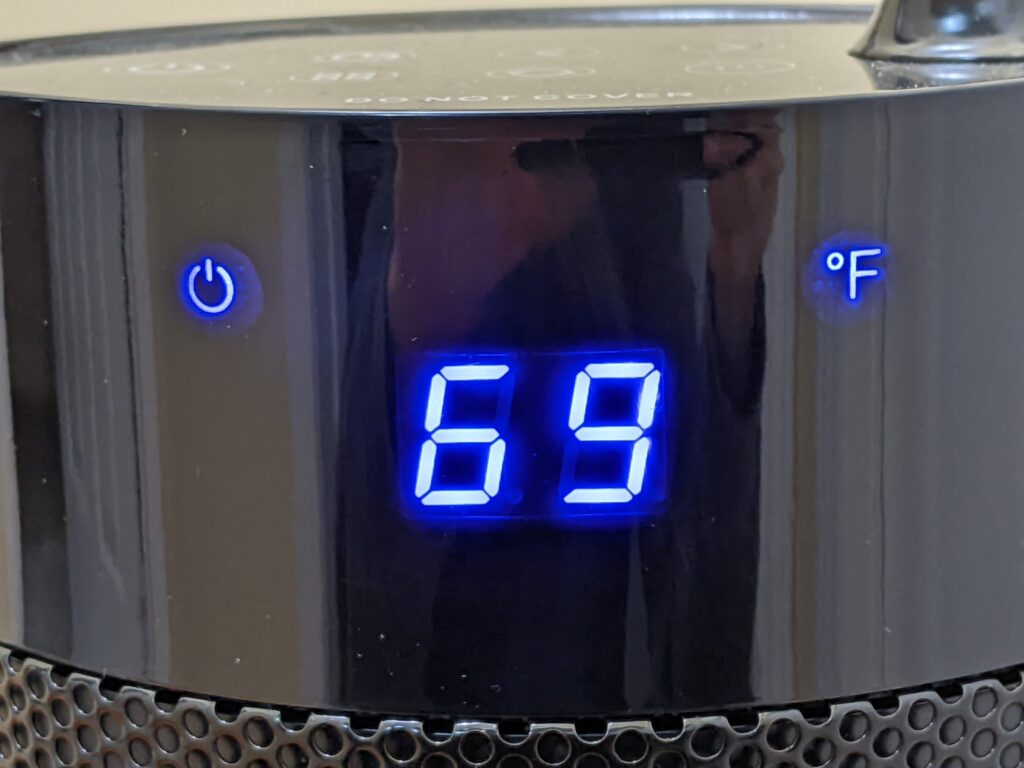With temperatures dropping Paris Rhone has released its latest tower heater to help you stay warm this Winter. Featuring a built in humidifier, this tower heater offers something a little more unique than what we normally see out of electrical heaters.
We had the opportunity to review De’Longhi’s full room panel heater and were very impressed and so the question for us when we received this tower heater, was whether or not it would impress us just as much. Here is what we found.
BUILD
The Paris Rhone 2-in-1 tower heater, stands 30 inches tall with a circular base that measures approximately 10 inches wide. Attaching the base to the tower is the only assembly required. While Paris Rhone provides the screws, you will need a Phillips head screwdriver to accomplish this task. When we finished assembling the base to the heater we still noticed that the unit was not as sturdy as we would have hoped with a slight wobble if pushed.
The heater has a modern and elegant look due to it’s mainly all black finish and digital display located at the front of the tower. On the top, you will find a simple and organized control panel as well as the spout where the heated mist is released by the built in humidifier.

On the back of the tower heater, there is a handle which allows you to lift the tower heater and move it from room to room based on your needs. When fully assembled the tower heater weighs just 6.8 pounds. Also on the back is the air inlet which is four inches wide by nine inches high. Below that lies the compartment housing the humidifier’s one-litre water container.
Finally, at the bottom of the unit is the drainage mechanism and rocker switch to power the unit on and off.
Heating mechanism
The Paris Rhone tower heater uses a PTC (Positive Temperature Coefficient) mechanism of heating. Inside the unit you can see several blocks of ceramic plates with aluminum fins attached. When an electric current heats the blocks, they in turn heat the fins, which heat the air.
The tower heater contains two fans, one above the other, that push the hot air out of the unit and dissipate into the area where you have the unit turned on and operating. These types of heaters are not significantly different than the idea behind LED lights which sit on a bed of ceramic, but rather than emitting heat, LEDs on ceramic blocks emit light, and can often be brighter than other forms of LED lights.

These types of electric heaters have the capability to heat up very quickly depending on the amount of ceramic blocks inside. Multiple tests validated the claim by Paris Rhone that the tower heater could begin producing heat in just two seconds.
Although the ability to generate heat quickly is very useful we had some issues related to the heating mechanism.
First, we found that the level of not air being dispersed by the Parish Rhone tower heater to be below that of the of other heaters such as the De’Longhi panel heater that we reviewed. The De’Longhi panel heater was able to consistently push heated air out of its heating mechanism at a rate of more than 2.00 meters per second while the Paris Rhone’s fans are only capable and pushing out hot air at a rate of 1.27 meters per second. This is a significant difference and means that the De’Longhi heater essentially dissipate more hot air than the Paris Rhone heater all things being equal, and when you wish to heat up a room, the more air that your heater can process and expel, the better.
Second, and as an extension of our first point, we found that this tower heater just didn’t have the ability to warm up a room evenly. We surmise that this maybe due to the heater’s directional heating which flows out from the front side only, whereas a panel heater such as the De’Longhi pushes hot air out in three different directions enveloping a room with heat. Although the Paris Rhone tower heater has an oscillating function of up to 70 degrees, the heater tends to warm up a room more like a moving wave going across. As a result, we noticed differences in temperature between different areas of a room being warmed up by the tower heater.
Humidifier
One aspect of the Paris Rhone tower heater that we really like is the unit’s ability to disperse mist into the air. The humidifier effectively keeps a room’s air from becoming too dry while the heater is operating.
Dry air has been associated with respiratory ailments such as asthma, bronchitis and nose bleeds among others. We found that while using the Paris Rhone tower heater, relative humidity remain unchanged or decreased only slightly while the humidifier and heater were both working at the same time.

It is worth pointing out that the heater and humidifier are independent of one another. Put another way, you can use either the heater without the humidifier running or vice-versa.
Display Panel
The LCD display panel on the top of the tower heater allows you to control the unit’s heating and humidifying functions. There are seven buttons in total summarized below.
POWER: The power button on the top of the tower heater activates the unit and sets it into standby mode. This is different than the rocker switch located on the back of the heater which turns the tower heater on and off.
TIMER: The timer button allows you to set up a predetermined length of time for the heater to operate. This tower heater has a minimum time of one hour and a maximum time limit of 12 hours. By repeatedly pressing the timer button you increase the length of time you want the heater to stay on before automatically shutting down. Increments are in one hour units.
TEMPERATURE INCREASE/DECREASE: The temperature increase and decrease buttons on the control panel are really self explanatory. You can adjust the temperature for the heater to as low as 50 degrees Fahrenheit or to has high as 95 degrees Fahrenheit. Temperature ranges adjust in increments of single degrees. The default temperature is 77 degrees Fahrenheit. Incidentally, there is no way to convert from Fahrenheit to Celsius.
POWER LEVEL: The Paris Rhone 2-in-1 tower heater can operate at three different levels – low, medium and high. At its maximum heat output, the heater’s energy consumption is 1500 Watts, while at its medium level, energy consumption is 1000 Watts.
OSCILLATION: The oscillating button simply turns that functionality on or off. When on, the heater has an oscillating angle of 70 degrees. While we have seen other heaters with more impressive side to side coverage, the 70 degree level is one we prefer since it allows the heater return to areas it has previously heated more quickly.
MIST: The mist button creates a regular mist that helps keep the relative humidity within a room at a sufficient level while the heater is operating. This can also be used without the heater operating.

To use the heater, you simply set the target temperature you want the temperature in a room to reach, and the heater will begin dispersing hot air almost immediately and will continue to do so until the target temperature is reached, after which the heater will continue to maintain the target temperature.
Also included with the PTC tower heater is a remote which allows you to control the heater and humidifier from a distance. The inclusion of a remote is something that we believe an end user will enjoy as it creates added convenience.

Safety mechanisms
By their nature, PTC electric heaters are very safe however the Paris Rhone tower heater has additional safety features that are present in many heaters today. For example, if you tip the tower heater over at an angle of more than 45 degrees, the Paris Rhone tower heater automatically shuts off.
Additionally, the heater contains flame retardant materials and has overheating protection sensors installed ensuring that there will be little cause for concern using the product as long as one employs common sense while operating the unit.
Noise and airflow
Although heating capability may be the primary concern when evaluating a heater, there may also be additional secondary considerations worth keeping in mind. One of those may very well be the level of noise that a heater makes while in operation.
Using a decibel meter we took an average reading of the level of noise generated by the Paris Rhone tower heater while running at full power at a distance of one foot from the front of the unit. We measured the average decibel reading at just over 60 which is equivalent to the level of noise created by two people having a regular conversation. This value comes in somewhat higher than the 51 decibels we measured coming from the De’Longhi panel heater when operating at full power.
Airflow is something that we consider to be quite important for a heater as well, since the amount of hot air that is dispersed has a direct correlation with how quickly a room can be warmed up bringing comfort to anyone in that room.
Using an anemometer at a distance of one foot, we took an average measure for the speed of air coming out of the front grill while the tower heater was operating at full power. We found the air speed to be between 1.25 and 1.30 metres per second. This level of air dispersion is well below that of the De’Longhi panel heater which averages 2.00 metres per second for the air being expelled from the top of that unit, with lower speeds for the hot air coming out through the side grills.

Cost considerations
Costs associated with heating your home are rising, and so one potential alternative could be the addition of an electrical heater.
As part of our overall evaluation we looked at the costs associated with operating the Paris Rhone tower heater at full power for three hours per day for a period of one month, or 30 days. At its maximum power, the heater consumes 1500 Watts of energy. We also noted that electrical costs per kWh based on Enbridge pricing for the province of Ontario at $0.098/kWh.
If we use the Paris Rhone tower heater for three hours per day over 30 days (or one month), the total operating costs associated for the heater based on Enbridge pricing, works out to $13.23 per month. This number is consistent for other heaters consuming 1500 Watts of energy. In our opinion, this level of expenditure is both reasonable and economical depending on your use case and heating considerations.
What we like
Small footprint: With a diameter of just 10 inches, the Paris Rhone can be placed just about anywhere in your living space.
Fast heating: We found the claim that the unit can begin generating heat in just two seconds to be accurate. If you are looking for a heater that can immediately begin dissipating heat, this is the one.
Remote: The inclusion of a remote to allow you to control the heater from across the room is very convenient. There is no need to recharge or replace batteries either.
Intuitive control panel: The control panel at the top of the unit is very simple to understand and simple to use, making this tower heater a product that can be used by those that are tech savvy and those who are not.
Humidifier: We really like the inclusion of a humidifying capability to the tower heater. All heaters generally dry out the air around where they operate and the ability to keep the relative humidity in a room from becoming too dry is certainly a feature some may find especially useful. Furthermore, the humidifying aspect of the heater can be used independently from the heating functions of the unit giving you essentially two products in one.
Safety mechanisms: The tower heater has an auto-shutoff mode when tipped more than 45 degrees. We are seeing this more and more in all heaters coming onto the market. The interior is also well made and contains flame retardant materials which we are also seeing more of across the industry. Still, we would advise caution especially around children and pets.
Portability: At just under seven pounds, the Paris Rhone tower heater can be easily moved from room to room. The company has also included a clever handle on the back of the unit that allows for an easy and comfortable grip.
Long timer: A twelve hour timer is something that we welcome. Lower level heaters tend only to have a timer that reaches just eight hours of operation.
What we don’t like
Lack of power: Although rated at 1500 Watts, the hot air dispersion by the Paris Rhone tower heater is below that of De’Longhi panel heater. This is an important point to make since both heaters have the same operating costs at maximum power, but the De’Longhi has the capability to not only heat a small or medium sized room but can also heat up large rooms as well, offering greater versatility.
Uneven heating: The Paris Rhone tower heater produces uneven heating based on our evaluation and testing. We found that whether or not the oscillating function was activated, the unit still had significant temperature differences in various parts of the room. While this is not very unusual, the gap between the top temperatures and low temperatures were.
Noise: The 60 decibel level we measured for the tower heater is louder than we would like and more loud then large room air purifiers as well as other electrical heaters. You will hear this heater at work during the night and it may make falling asleep more of a challenge.
Final thoughts
The ability to heat one’s living space this winter is proving to be more challenging than perhaps at anytime before. Additionally, making the right economical choice can be a challenge given the wide array of heaters on the market.
Our look at the Paris Rhone tower heater revealed that this heater can compliment smaller living spaces but faces challenges providing enough warmth to heat larger rooms.
While the heater has the ability to almost instantly generate heat, it lacks the ability to evenly heat a room. The result is that portions of a room where the heater’s front grill is pointed, enjoy warmth, while other parts of a room take much longer to warm up.
The humidifier is a nice addition by Paris Rhone. Since it can operate independently of the heater, the humidifier can be used throughout the year. Furthermore, while using the heater and humidifier together, humidity in a room can be maintained and we found that the humidifier did a good job in preventing the air in a room from becoming uncomfortably dry.
Additional considerations that we focused on including operational cost, noise and airflow. These factors demonstrated that the Paris Rhone tower heater underperforms the competition and so while we see value in the humidifying function of the tower heater, when we sum up all of the pros and cons of the tower heater we would tend to consider it to be somewhat of an underperformer. If however, you are looking to heat up a small living space we think the Paris Rhone tower heater would be adequate especially given its small footprint, but beyond that, if the humidifying function is not a significant priority and you are looking to heat a medium to large-sized room, we would look elsewhere for an electrical heating option.
For the latest price and further information on the Paris Rhone 2-in-1 PTC tower heater please click on the buttons below.